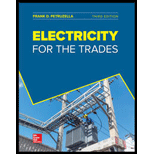
ELECTRICITY FOR TRADES (LOOSELEAF)
3rd Edition
ISBN: 9781260437454
Author: Petruzella
Publisher: MCG
expand_more
expand_more
format_list_bulleted
Concept explainers
Textbook Question
Chapter 11.1, Problem 2RQ
- a. State the current characteristic of a series circuit.
- b. Express this characteristic in the form of an equation.
Expert Solution & Answer
Trending nowThis is a popular solution!

Students have asked these similar questions
Don't use ai to answer I will report you answer
12.21 Determine iL(t) in the circuit of Fig. P12.21 for t ≥ 0,given that the switch was opened at t = 0 after it had been closedfor a long time, us = 12 mV, R0 = 5 W, R1 = 10 W, R2 = 20 W,L = 0.2 H, and C = 6 mF.
12.20 Determine uout(t) in the circuit in Fig. P12.20, given thatus(t) = 35u(t) V, uC1(0−) = 20 V, uC2 (0−) = 0, R1 = 1 W,C1 = 1 F, R2 = 0.5 W, and C2 = 2 F.
Chapter 11 Solutions
ELECTRICITY FOR TRADES (LOOSELEAF)
Knowledge Booster
Learn more about
Need a deep-dive on the concept behind this application? Look no further. Learn more about this topic, electrical-engineering and related others by exploring similar questions and additional content below.Similar questions
- 12.16 In the circuit of Fig. P12.16, us(t) is a rectangular 5-Vpulse of duration 3 seconds starting at t = 0. Determine iL(t) fort ≥ 0, given that R1 = 6 W, L = 1 H, and C = 13 F. Assume thatinitially the capacitor had no charge stored in it.arrow_forwardA rectangular waveguide with dimensions a = 2.5 cm, b = 1 cm is to operate below 15.1 GHz. How many TE and TM modes can the waveguide transmit? if the guide is filled with a medium characterized by σ = 0, ε = 4 εor fr = 1' Calculate the cutoff frequencies of the modes.arrow_forwardConsider the waveguide Calculate the phase constant, phase velocity and wave impedance for TE10 and TM11 modes at the operating frequency of 15 GHz. Answer: For TE10, 6 = 615.6 rad/m, u = 1.531 × 108 m/s, TE = 192.4. For TM11, B = 529.4 rad/m, u = 1.78 × 10° m/s, TM = 158.8 0.arrow_forward
- An air-filled 5- by 2-cm waveguide has Ezs = 20 sin 40лx sin 50лу eBz v/m at 15 GHz. (a) What mode is being propagated? (b) Find B. (c) Determine Ey/Ex. Answer: (a) TM21, (b) 241.3 rad/m, (c) 1.25 tan 40лx cot 50ду.arrow_forwardWrite the general instantaneous field expressions for the TM and TE modes. Deduce those TE01 and TM12 modes.arrow_forward2B: The relays of type ID_MT on The Feeders circuit breakers have a current setting of 125% CT ratio yoo/5 and atime multiplier setting of 400/5 0.5A three phase fault current of 5000A Flows through feeders, The characteristics of The relay given in atable for PS_M=1 calculate: Ⓒ Feeders relay current RSM and The actual operating time IF The Feeder supplied by transformer Find The TSM For The trans former overcurrent relay Take The discrimination time 0.5 sec. CT ratio 1000/ and CS-100% 10621.7 PSM: Time sec 2.2 20 16 12 2.5 2.75 3 3.8 10 12arrow_forward
- Don't use ai to answer I will report you answerarrow_forwardDon't use ai to answer I will report you answerarrow_forwardThe quantum efficiency of a pin-photodiode is 75 % at a wavelength of 1320 nm. The diode’s capacitance is 11 pF. For an input optical power of 1 mW, evaluate the mean (4)arrow_forward
- Don't use ai to answer I will report you answerarrow_forwardanA fluid level control system includes a tank, a level sensor , a fluid source and an actuator to control fluid inflow. Show how the fluid level could be digitally controlled using a block diagramarrow_forwardsee the following imagearrow_forward
arrow_back_ios
SEE MORE QUESTIONS
arrow_forward_ios
Recommended textbooks for you
 Delmar's Standard Textbook Of ElectricityElectrical EngineeringISBN:9781337900348Author:Stephen L. HermanPublisher:Cengage Learning
Delmar's Standard Textbook Of ElectricityElectrical EngineeringISBN:9781337900348Author:Stephen L. HermanPublisher:Cengage Learning

Delmar's Standard Textbook Of Electricity
Electrical Engineering
ISBN:9781337900348
Author:Stephen L. Herman
Publisher:Cengage Learning
Current Divider Rule; Author: Neso Academy;https://www.youtube.com/watch?v=hRU1mKWUehY;License: Standard YouTube License, CC-BY